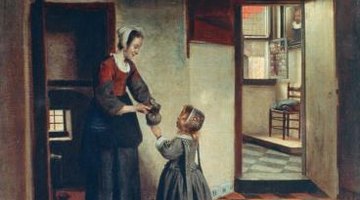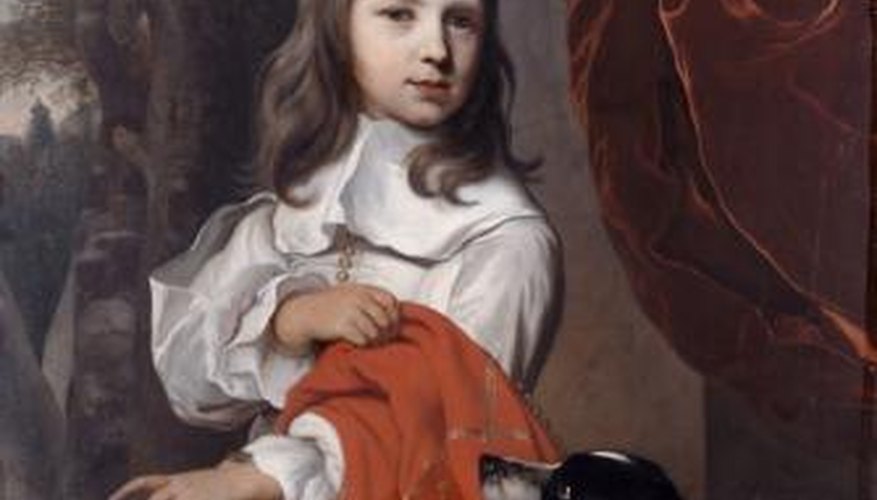In European portraits of the 1600s, children of the era resemble miniature adults. Little girls wear gowns similar to their mothers' and little boys appear to be smaller versions of their fathers. The quality of the fabric depended on the status and wealth of the parents. Indeed, clothing was a gauge of a family's means and status. Consequently, children were dressed to reflect their parents' place in society.
Infants
Both male and female infants wore a long-sleeved gown that covered their legs. To keep their heads warm, babies wore a wool or linen cap called a "biggin" tied under the chin. As a baby began to toddle, "leading strings" were attached to the child's gown and used to keep him from falling over. Padding known as "pudding" was wrapped around the child's forehead so that if he fell and bumped his head, he wouldn't be seriously injured.
- Both male and female infants wore a long-sleeved gown that covered their legs.
- As a baby began to toddle, "leading strings" were attached to the child's gown and used to keep him from falling over.
Boys
As they neared school age, little boys wore a doublet, or fitted jacket, over a shirt and wool petticoats. When the parents felt the time was right, a boy would begin to wear trousers -- or breeches. This was referred to as "breeching" and signalled a change in a boy's status when he would begin to spend more time with his father. Under their breeches boys wore tights, which were tied with ribbons to keep them from falling down.
- As they neared school age, little boys wore a doublet, or fitted jacket, over a shirt and wool petticoats.
- When the parents felt the time was right, a boy would begin to wear trousers -- or breeches.
Girls

Little girls continued wearing a bigger version of their nursery gown until they reached about 7 years of age. At that age, a girl donned a boned corset over her chemise -- an undergarment similar to a full slip. Over the corset, girls wore a waistcoat, which resembled a boy's doublet, fitted and typically made of heavy cotton or wool. Beneath the corset and waistcoat, a girl wore one or more petticoats, which provided warmth in cold weather. Finally, girls wore stockings held up by garters.
- Little girls continued wearing a bigger version of their nursery gown until they reached about 7 years of age.
- Beneath the corset and waistcoat, a girl wore one or more petticoats, which provided warmth in cold weather.
Boys and Girls
Boys and girls of all ages wore pinafores, or aprons, to protect their clothes from getting dirty. Pinafores were typically made of linen, either plain or finely embroidered. Older boys might wear a shorter version made of leather. Boys and girls also wore linen collars, sometimes trimmed in lace. To top off an ensemble, a boy wore a woollen cap or wide-brimmed felt hat. Girls wore a felt hat over a linen "coif," which was a cap that fit over their pinned-back hair.
- Boys and girls of all ages wore pinafores, or aprons, to protect their clothes from getting dirty.
- Girls wore a felt hat over a linen "coif," which was a cap that fit over their pinned-back hair.
